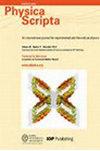(n, 2, d) 全相关多分量贝尔函数的迭代公式及其应用
IF 2.6
3区 物理与天体物理
Q2 PHYSICS, MULTIDISCIPLINARY
引用次数: 0
摘要
无论出于科学还是技术原因,构建多方和高维系统的贝尔不等式都是一项重要任务。Mermin-Ardehali-Belinskiĭ-Klyshko(MABK)不等式以迭代公式和相关函数的形式表达,是 Clauser-Horne-Shimony-Holt (CHSH)不等式在多对偶情况下的推广。在检测相应量子系统中白噪声最大的纠缠态的非局域性意义上,以联合概率形式表示的柯林斯-吉辛-林登-马萨-波佩斯库(CGLMP)不等式是联合概率上的克劳瑟-霍恩(CH)不等式的高维类似形式。从检测 n-qudit 系统中具有最多白噪声的 Greenberger-Horne-Zeilinger(GHZ) 噪声态的非局域性的意义上讲,用迭代公式和相关函数来构造 CGLMP 不等式的多方类比是一项具有挑战性的任务。本文将双位 d 维系统的多分量相关函数 [Phys. Rev. A 71, 032 107 (2005)]推广到 n 位 d 维系统,引入一般的全相关多分量贝尔函数 ,并构造相应的贝尔不等式。受 MABK 不等式迭代公式形式的启发,我们证明对于质数 d,一般贝尔函数可以通过迭代两个贝尔函数来重新表述。作为应用,对于质数 d,仅限于无偏对称(d × 2)端口分光器和有噪声的 n-qudit GHZ 状态,我们恢复了小 n 和 d 的最稳健贝尔不等式,如 (3,2,3)、(4,2,3)、(5,2,3) 和 (3,2,5) 贝尔情况下的迭代公式和 (2,2,d) 情况下的最稳健贝尔不等式。这意味着迭代公式是构建具有相关函数的 CGLMP 不等式的多方类似式的有效方法。此外,我们还给出了一些具有相同稳健性但与已知不等式不等的新贝尔不等式。本文章由计算机程序翻译,如有差异,请以英文原文为准。
The iteration formula of (n, 2, d) full-correlated multi-component Bell function and its applications
No matter for a scientific or technological reason, constructing Bell inequalities for multi-partite and high-dimensional systems is a significant task. The Mermin-Ardehali-Belinskiĭ-Klyshko (MABK) inequality is expressed in the form of iteration formula and correlation functions, and is the generalization of the Clauser-Horne-Shimony-Holt (CHSH) inequality to multi-partite cases. In the sense of detecting the nonlocality of the noisy maximally entangled states with the most white noises for the corresponding quantum system, the Collins-Gisin-Linden-Massar-Popescu (CGLMP) inequality, expressed in the joint probabilities form, is the high-dimensional analogue of the Clauser-Horne (CH) inequalities on joint probabilities. In the sense of detecting the nonlocality of the noisy Greenberger-Horne-Zeilinger(GHZ) states with the most white noises for the n-qudit system, it is a challenging task to construct the multi-partite analogue of the CGLMP inequality with iteration formula and correlation functions. In this paper, we generalize the multi-component correlation functions [Phys. Rev. A 71, 032 107 (2005)] for bipartite d-dimensional systems to n-partite d-dimensional ones, introduce the general full-correlated multi-component Bell function , and construct the corresponding Bell inequality. By this way, we can reproduce both the CGLMP inequality and the Bell inequality in [Phys. Rev. A 71, 032 107 (2005)] for the case n = 2, and the MABK inequality for the case d = 2. Inspired by the iteration formula form of the MABK inequality, we prove that for prime d the general Bell function can be reformulated by iterating two Bell functions . As applications, for prime d, confined to the unbiased symmetric (d × 2)-port beam splitters and the noisy n-qudit GHZ states, we recover the most robust Bell inequalities for small n and d, such as for the (3, 2, 3), (4, 2, 3), (5, 2, 3), and (3, 2, 5) Bell scenarios, with the iteration formula and the most robust Bell inequalities for the (2, 2, d) scenario. This implies that the iteration formula is an efficient way of constructing the multi-partite analogues of the CGLMP inequality with correlation functions. In addition, we also give some new Bell inequalities with the same robustness but inequivalent to the known ones.
求助全文
通过发布文献求助,成功后即可免费获取论文全文。
去求助
来源期刊

Physica Scripta
物理-物理:综合
CiteScore
3.70
自引率
3.40%
发文量
782
审稿时长
4.5 months
期刊介绍:
Physica Scripta is an international journal for original research in any branch of experimental and theoretical physics. Articles will be considered in any of the following topics, and interdisciplinary topics involving physics are also welcomed:
-Atomic, molecular and optical physics-
Plasma physics-
Condensed matter physics-
Mathematical physics-
Astrophysics-
High energy physics-
Nuclear physics-
Nonlinear physics.
The journal aims to increase the visibility and accessibility of research to the wider physical sciences community. Articles on topics of broad interest are encouraged and submissions in more specialist fields should endeavour to include reference to the wider context of their research in the introduction.
 求助内容:
求助内容: 应助结果提醒方式:
应助结果提醒方式:


